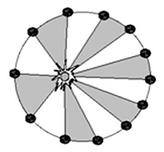Keplers Three Laws of Planetary Motion
Gravitation of Class 9
Kepler’s three laws of planetary motion can be described as follows :
1. The orbit of a planet is an ellipse with the sun at one of the foci, as shown in the figure given below. In this figure O is the position of the sun.

2. The line joining the planet and the sun sweeps equal areas in equal intervals of time. Thus, if the time of travel from A to B is the same as that from C to D, then the areas OAB and OCD are equal.

3. The cube of the mean distance of a planet from the Sun is proportional to the square of its orbital period T. Or, r3 / T2 = constant.
As an illustration, consider the orbital period and average distance from sun (orbital radius) for earth and mars as given in the table below.
Planet Period (s) Average Dist.(m) T2/R3 (s2/m3)
Earth 3.156 × 107 s 1.4957 × 1011 2.977 × 10-19
Mars 5.93 × 107 s 2.278 × 1011 2.975 × 10-19
Observe that the T2/R3 ratio is the same for earth as it is for mars. In fact, if the same T2/R3 ratio is computed for the other planets, it will be found that thisratio shows approximate agreement with the same value for both earth and mars.
BODIES FALLING NEAR THE SURFACE OF THE EARTH:
Galileo’s Observations on Falling Bodies:
The speed of falling body increases as it comes down. This means that the body accelerates, when it falls freely. Suppose we drop a coin and a feather from the same height simultaneously. Which will reach the ground first?
The answer is quite obvious, the coin will reach earlier than lighter feather or we can say that the heavier objects comes down more faster than lighter ones but such a generalization is not correct. If we take two slid balls of different masses, say, one of 5 kg and the other of 10 kg, and drop them from the same height, we will find that they reach the ground almost simultaneously.
It is said that Galileo dropped two stones of different masses from the Leaning Tower of Pisa (in Italy) and founded that they reached the ground simultaneously. Galileo argued that the air resist on object traveling through it. If the material is dense and its surface area is small, the resistance due to air is quite small compared to the force of gravity. Thus one can neglect the effect of air resistance while studying falling stones, metallic blocks, coins etc. But the effect of air resistance is very important for small pieces of paper, feather, leaves etc. each of which as a large surface area and low density. When a coin and a feather fall through air, air offers greater resistance to the motion of the feather and les resistance to the motion of the coin, According to Galileo’s argument, if air is totally removed, the coin and the feather will fall simultaneously.
Newton was born in the year Galileo died. Galileo died not have access to the equations for gravitational attraction and the acceleration resulting from a force. Still, he correctly predicted something from his observations that was contrary to everyday experience.
Galileo’s prediction was tested by the British scientist Robert Boyle. He kept a coin and a feather in a long glass tube and evacuated the air from inside the tube by using a vacuum pump. When the tube was inverted, the coin and the feather fell together.









